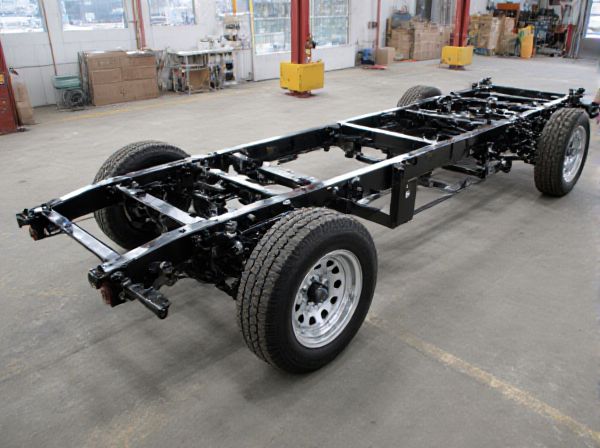
Photo illustration: Stamped Steel Chassis vs Aluminum Chassis
Stamped steel chassis offer exceptional durability and cost-effectiveness, making them ideal for vehicles that require high strength and impact resistance. Aluminum chassis provide significant weight reduction, enhancing fuel efficiency and handling performance while maintaining sufficient structural integrity. Choosing between the two depends on your priorities for vehicle performance, weight, and budget.
Table of Comparison
| Feature | Stamped Steel Chassis | Aluminum Chassis |
|---|---|---|
| Weight | Heavier, increases overall vehicle weight | Lighter, improves fuel efficiency and handling |
| Strength | High tensile strength, durable under stress | Good strength-to-weight ratio, can be reinforced |
| Corrosion Resistance | Prone to rust, requires protective coatings | Highly resistant to corrosion naturally |
| Cost | Lower manufacturing cost | Higher cost due to material and processing |
| Manufacturing | Established stamping process, faster production | Complex fabrication, often requires specialized welding |
| Repairability | Easier and cheaper to repair | More difficult and costly repairs |
| Performance | Solid structural integrity, less impact on agility | Enhances vehicle agility & acceleration due to reduced weight |
Introduction to Chassis Materials
Stamped steel chassis offer high strength and durability due to their robust material properties, making them ideal for heavy-duty applications and providing excellent impact resistance. Aluminum chassis, valued for their lightweight nature, improve fuel efficiency and handling by reducing overall vehicle weight while maintaining adequate structural integrity. Both materials play crucial roles in vehicle design, with stamped steel prioritizing strength and cost-effectiveness, and aluminum emphasizing weight reduction and performance.
What Is a Stamped Steel Chassis?
A stamped steel chassis is a vehicle frame formed by pressing flat steel sheets into precise shapes using heavy-duty stamping presses, resulting in strong and durable components. This type of chassis offers excellent impact resistance and rigidity, making it ideal for applications requiring high structural integrity and crash protection. Compared to aluminum chassis, stamped steel is generally heavier but provides superior strength and lower production costs.
What Is an Aluminum Chassis?
An aluminum chassis is a vehicle frame made from aluminum alloys, known for being lightweight yet strong, which enhances fuel efficiency and overall performance. Compared to stamped steel chassis, aluminum offers superior corrosion resistance and improved handling due to reduced weight. This results in better acceleration, braking, and increased durability under various driving conditions.
Weight Comparison: Steel vs Aluminum
Stamped steel chassis typically weigh significantly more than aluminum chassis, with steel's density around 7.85 g/cm3 compared to aluminum's 2.70 g/cm3. This weight difference directly impacts vehicle fuel efficiency and handling, as aluminum chassis offer substantial reductions in overall vehicle mass. Manufacturers often prefer aluminum for performance vehicles due to its superior strength-to-weight ratio, improving acceleration and braking dynamics.
Strength and Durability Factors
Stamped steel chassis offer superior strength and impact resistance due to the material's high tensile strength and ability to absorb energy during collisions, making it ideal for heavy-duty applications. Aluminum chassis provide excellent durability by resisting corrosion and fatigue over time, contributing to longer vehicle lifespan and reduced maintenance costs. Despite aluminum's lighter weight enhancing fuel efficiency, steel remains the preferred choice when maximum structural integrity and crash safety are critical.
Cost Analysis: Manufacturing and Maintenance
Stamped steel chassis offer lower initial manufacturing costs due to the widespread availability of steel and efficient stamping processes, making them a budget-friendly choice for mass production. Aluminum chassis, while more expensive upfront owing to higher material costs and specialized fabrication techniques, provide long-term savings through reduced maintenance needs, corrosion resistance, and improved fuel efficiency from lighter weight. The total cost of ownership favors stamped steel for low-cost vehicles, whereas aluminum chassis benefits applications prioritizing durability and lifecycle cost reduction.
Corrosion Resistance and Longevity
Stamped steel chassis offer excellent strength but are more prone to corrosion over time, necessitating protective coatings or treatments to enhance durability. Aluminum chassis provide superior corrosion resistance due to their natural oxide layer, contributing to longer lifespan in harsh environments. Vehicles with aluminum chassis typically experience reduced maintenance costs and improved longevity compared to stamped steel counterparts.
Performance and Handling Differences
Stamped steel chassis offer greater rigidity and durability, enhancing vehicle stability during aggressive driving and improving crash safety. Aluminum chassis provide superior weight reduction, resulting in better acceleration, braking, and fuel efficiency while contributing to a lower center of gravity for improved cornering performance. The choice between stamped steel and aluminum significantly impacts overall vehicle dynamics, with steel favoring strength and aluminum optimizing lightweight agility.
Environmental Impact and Sustainability
Stamped steel chassis typically have a higher carbon footprint due to the energy-intensive processes in steel production and heavier weight contributing to increased fuel consumption. Aluminum chassis offer improved sustainability by being lighter, which enhances fuel efficiency and reduces emissions during vehicle operation, although aluminum manufacturing demands significant energy input, often offset by its recyclability. Choosing between stamped steel and aluminum chassis involves balancing initial environmental costs with long-term benefits from weight reduction and material recyclability.
Which Chassis Is Right for You?
Stamped steel chassis offer superior strength and durability at a lower cost, making them ideal for heavy-duty or budget-conscious applications. Aluminum chassis provide lighter weight and enhanced corrosion resistance, improving fuel efficiency and handling for performance-oriented vehicles. Choosing between the two depends on your priorities: durability and cost-efficiency favor stamped steel, while weight savings and longevity benefit from aluminum construction.
 caratoz.com
caratoz.com